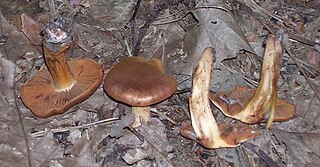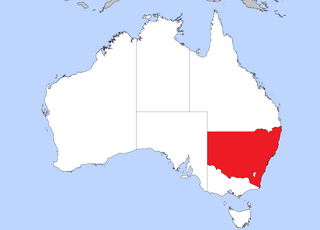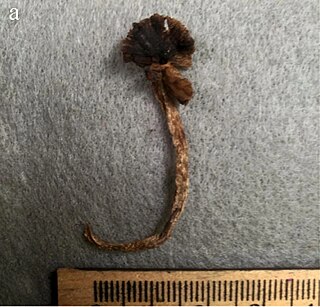
Mount Field National Park is a national park in Tasmania, Australia, 64 km northwest of Hobart. The landscape ranges from eucalyptus temperate rainforest to alpine moorland, rising to 1,434 metres (4,705 ft) at the summit of Mount Field West.

Cortinarius rubellus, commonly known as the deadly webcap, is a species of fungus in the family Cortinariaceae, native to high-latitude temperate to subalpine forests of Eurasia and North America. Within the genus it belongs to a group known as the Orellani, all of which are highly toxic. Eating them results in kidney failure, which is often irreversible. The mushroom is generally tan to brown all over, with a conical to convex cap 2.5 to 8 centimetres in diameter, adnate gills and a 5.5 to 11 cm tall stipe.

Cortinarius is a globally distributed genus of mushrooms in the family Cortinariaceae. It is suspected to be the largest genus of agarics, containing over 2,000 widespread species. A common feature among all species in the genus Cortinarius is that young specimens have a cortina (veil) between the cap and the stem, hence the name, meaning curtained. Most of the fibres of the cortina are ephemeral and will leave no trace once gone, except for limited remnants on the stem or cap edge in some species. All have a rusty brown spore print. The common names cortinar and webcap refer to members of the genus. Due to dangerous toxicity of several species and the fact that it is difficult to distinguish between various species of the genus, non-expert consumption of mushrooms from the genus is discouraged.

The Cortinariaceae are a large family of gilled mushrooms found worldwide, containing over 2100 species. The family takes its name from its largest genus, the varied species of the genus Cortinarius. Many genera formerly in the Cortinariaceae have been placed in various other families, including Hymenogastraceae, Inocybaceae and Bolbitiaceae.

Cortinarius caperatus is an edible mushroom of the genus Cortinarius found in northern regions of Europe and North America. It was known as Rozites caperata for many years before genetic studies revealed that it belonged to the genus Cortinarius. The fruit bodies appear in autumn in coniferous and beech woods as well as heathlands in late summer and autumn. The ochre-coloured cap is up to 10 cm (4 in) across and has a fibrous surface. The clay-colored gills are attached to the stipe under the cap, and the stipe is whitish with a whitish ring. The Latin specific name, caperatus, means wrinkled, and refers to the distinctive texture of the cap. The flesh has a mild smell and flavor.

Cortinarius mucosus, commonly known as the orange webcap or the slimy cortinarius, is a species of mushroom in the family Cortinariaceae. In North America, the species is more commonly associated with northern coniferous forests. The specific epithet is derived from the Latin word mucosus, meaning mucus.

Cortinarius rotundisporus, also known as the elegant blue webcap, is a basidiomycete mushroom of the genus Cortinarius found in southern Australia, where it is found in eucalypt forests and rainforests. The cap of the fruit body is a steely blue colour, with a yellowish boss, and paler similarly coloured stipe.

Cortinarius violaceus, commonly known as the violet webcap or violet cort, is a fungus in the webcap genus Cortinarius native across the Northern Hemisphere. The fruit bodies are dark purple mushrooms with caps up to 15 cm (6 in) across, sporting gills underneath. The stalk measures 6 to 12 centimetres by 1 to 2 cm, sometimes with a thicker base. The dark flesh has a smell reminiscent of cedar wood. Forming symbiotic (ectomycorrhizal) relationships with the roots of various plant species, C. violaceus is found predominantly in conifer forests in North America and deciduous forests in Europe.

Cortinarius archeri is a species of mushroom in the genus Cortinarius native to Australia. The distinctive mushrooms have bright purple caps that glisten with slime, and appear in autumn in eucalypt forests.

Cortinarius infractus, commonly known as the sooty-olive Cortinarius or the bitter webcap, is an inedible basidiomycete mushroom of the genus Cortinarius. The fungus produces sooty-olive fruit bodies with sticky caps measuring up to 13 cm (5.1 in) in diameter. The fruit bodies contains alkaloids that inhibit the enzyme acetylcholinesterase.

Cortinarius cinnamomeus, also known as the cinnamon webcap, is a basidiomycete mushroom of the genus Cortinarius. The fungus produces brown fruit bodies with caps up to 6 cm (2.4 in) wide and stems up to 12 cm (4.7 in) long. The closely crowded gills underside the cap are initially yellow before turning brown. Cortinarius cinnamomeus is common in damp places in coniferous forests. It is distributed throughout the temperate zone of the Northern Hemisphere.

Cortinarius anomalus, also known as the variable webcap, is a basidiomycete fungus of the genus Cortinarius. It produces a medium-sized mushroom with a grayish-brown cap up to 5 cm (2 in) wide, gray-violet gills and a whitish stem with pale yellow belts below. The mushroom grows solitarily or in scattered groups on the ground in deciduous and coniferous forests. It is found throughout the temperate zone of the northern hemisphere.

The Orellani are a group of seven related species in the genus Cortinarius that have been classified as a section of the subgenus Leprocybe or a subgenus in their own right. They are among world's most poisonous mushrooms as they contain the highly toxic compound orellanine. The best-known species are the deadly webcap and the fool's webcap, C. orellanus.

Cortinarius orellanus, commonly known as the fool's webcap or fools webcap, is a species of deadly fungus in the family Cortinariaceae native to Europe. Within the genus it belongs to a group known as the Orellani, all of which are highly toxic—eating them results in kidney failure, which is often irreversible. The mushroom is generally tan to brown all over.

Cortinarius vanduzerensis is a species of mushroom in the family Cortinariaceae. Described as new to science in 1972, it is known only from the Pacific Northwest region of North America, where it grows under conifers such as spruce, hemlock, and Douglas-fir. The fruit bodies of the fungus, or mushrooms, have a slimy dark chestnut-brown cap that becomes deeply radially grooved or corrugated in maturity, and reaches diameters of up to 8 cm. The gills on the underside of the cap are initially pinkish-buff before becoming pale brown when the spores mature. The stem is lavender, measuring 10–18 cm (4–7 in) long and 1–2 cm thick. The mushroom produces a rusty-brown spore print, with individual spores measuring 12–14 by 7–8 micrometers. The edibility of the mushroom has not been determined, and it has been described as "much too slippery to be of value".

Meinhard Michael Moser was an Austrian mycologist. His work principally concerned the taxonomy, chemistry, and toxicity of the gilled mushrooms (Agaricales), especially those of the genus Cortinarius, and the ecology of ectomycorrhizal relationships. His contributions to the Kleine Kryptogamenflora von Mitteleuropa series of mycological guidebooks were well regarded and widely used. In particular, his 1953 Blätter- und Bauchpilze [The Gilled and Gasteroid Fungi ], which became known as simply "Moser", saw several editions in both the original German and in translation. Other important works included a 1960 monograph on the genus Phlegmacium and a 1975 study of members of Cortinarius, Dermocybe, and Stephanopus in South America, co-authored with the mycologist Egon Horak.

Cortinarius kaputarensis is a species of truffle-like fungus in the family Cortinariaceae. Described as a new species in 2010, it is known only from New South Wales in Australia.

Cortinarius kioloensis is a fungus native to Australia. It was described in 2009 by Alec Wood, and is related to the Northern Hemisphere species Cortinarius violaceus.

Cortinarius aurae is a little brown mushroom found in Europe and North America, originally described from a UK specimen in 2020. It was named in honour of the describing authors' new born daughter. Along with five other British webcaps, C. aurae was selected by Kew Gardens as a highlight of taxa described by the organisation's staff and affiliates in 2020.
















